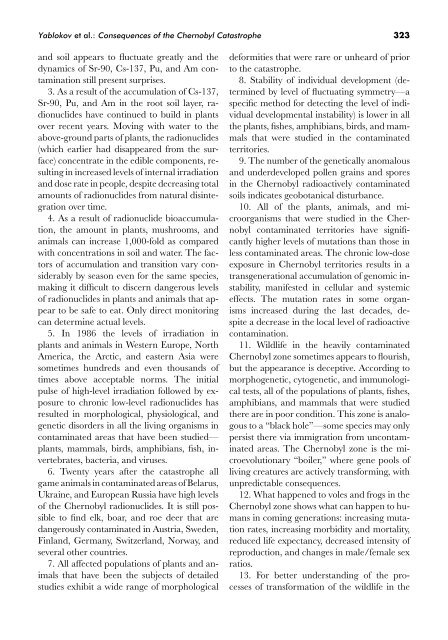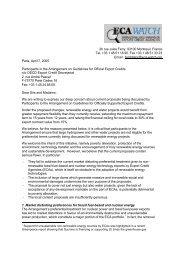PDF copy of 2009 book
PDF copy of 2009 book
PDF copy of 2009 book
Create successful ePaper yourself
Turn your PDF publications into a flip-book with our unique Google optimized e-Paper software.
Yablokov et al.: Consequences <strong>of</strong> the Chernobyl Catastrophe 323and soil appears to fluctuate greatly and thedynamics <strong>of</strong> Sr-90, Cs-137, Pu, and Am contaminationstill present surprises.3. As a result <strong>of</strong> the accumulation <strong>of</strong> Cs-137,Sr-90, Pu, and Am in the root soil layer, radionuclideshave continued to build in plantsover recent years. Moving with water to theabove-ground parts <strong>of</strong> plants, the radionuclides(which earlier had disappeared from the surface)concentrate in the edible components, resultingin increased levels <strong>of</strong> internal irradiationand dose rate in people, despite decreasing totalamounts <strong>of</strong> radionuclides from natural disintegrationover time.4. As a result <strong>of</strong> radionuclide bioaccumulation,the amount in plants, mushrooms, andanimals can increase 1,000-fold as comparedwith concentrations in soil and water. The factors<strong>of</strong> accumulation and transition vary considerablyby season even for the same species,making it difficult to discern dangerous levels<strong>of</strong> radionuclides in plants and animals that appearto be safe to eat. Only direct monitoringcan determine actual levels.5. In 1986 the levels <strong>of</strong> irradiation inplants and animals in Western Europe, NorthAmerica, the Arctic, and eastern Asia weresometimes hundreds and even thousands <strong>of</strong>times above acceptable norms. The initialpulse <strong>of</strong> high-level irradiation followed by exposureto chronic low-level radionuclides hasresulted in morphological, physiological, andgenetic disorders in all the living organisms incontaminated areas that have been studied—plants, mammals, birds, amphibians, fish, invertebrates,bacteria, and viruses.6. Twenty years after the catastrophe allgame animals in contaminated areas <strong>of</strong> Belarus,Ukraine, and European Russia have high levels<strong>of</strong> the Chernobyl radionuclides. It is still possibleto find elk, boar, and roe deer that aredangerously contaminated in Austria, Sweden,Finland, Germany, Switzerland, Norway, andseveral other countries.7. All affected populations <strong>of</strong> plants and animalsthat have been the subjects <strong>of</strong> detailedstudies exhibit a wide range <strong>of</strong> morphologicaldeformities that were rare or unheard <strong>of</strong> priorto the catastrophe.8. Stability <strong>of</strong> individual development (determinedby level <strong>of</strong> fluctuating symmetry—aspecific method for detecting the level <strong>of</strong> individualdevelopmental instability) is lower in allthe plants, fishes, amphibians, birds, and mammalsthat were studied in the contaminatedterritories.9. The number <strong>of</strong> the genetically anomalousand underdeveloped pollen grains and sporesin the Chernobyl radioactively contaminatedsoils indicates geobotanical disturbance.10. All <strong>of</strong> the plants, animals, and microorganismsthat were studied in the Chernobylcontaminated territories have significantlyhigher levels <strong>of</strong> mutations than those inless contaminated areas. The chronic low-doseexposure in Chernobyl territories results in atransgenerational accumulation <strong>of</strong> genomic instability,manifested in cellular and systemiceffects. The mutation rates in some organismsincreased during the last decades, despitea decrease in the local level <strong>of</strong> radioactivecontamination.11. Wildlife in the heavily contaminatedChernobyl zone sometimes appears to flourish,but the appearance is deceptive. According tomorphogenetic, cytogenetic, and immunologicaltests, all <strong>of</strong> the populations <strong>of</strong> plants, fishes,amphibians, and mammals that were studiedthere are in poor condition. This zone is analogousto a “black hole”—some species may onlypersist there via immigration from uncontaminatedareas. The Chernobyl zone is the microevolutionary“boiler,” where gene pools <strong>of</strong>living creatures are actively transforming, withunpredictable consequences.12. What happened to voles and frogs in theChernobyl zone shows what can happen to humansin coming generations: increasing mutationrates, increasing morbidity and mortality,reduced life expectancy, decreased intensity <strong>of</strong>reproduction, and changes in male/female sexratios.13. For better understanding <strong>of</strong> the processes<strong>of</strong> transformation <strong>of</strong> the wildlife in the




